This kookoo sabzi (kuku sabzi) is an aromatic quiche filled with six different herbs and greens. It’s a staple dish to celebrate the first day of Spring and the Persian New Year (Nowruz).
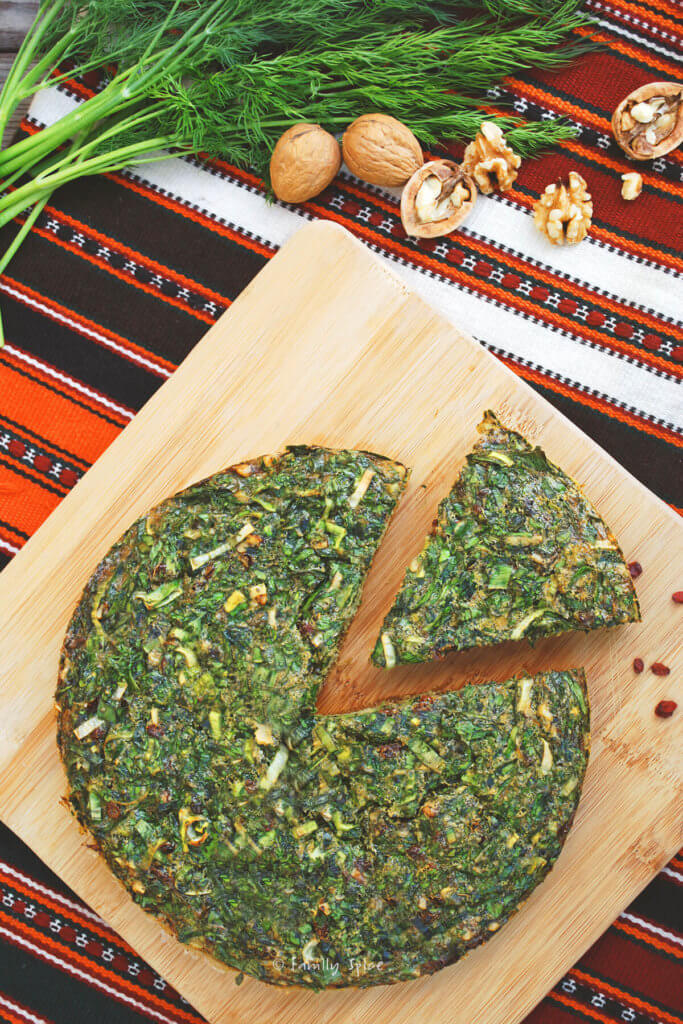
Every year, the approach of spring and Nowruz (Persian New Year) brings a smile to face. It not only reminds me that winter is almost over, but it also brings about all the beautiful traditions I love about this holiday.
The first day of Spring falls on March 20th, the spring equinox. And the first day on the Iranian calendar (Nowruz/Norouz/Noruz) falls on the the first day of spring. Along with the traditions of the sofreh haft sin and the fire jumps on Chahr-Shambeh Souri, there are certain foods we Persians eat to celebrate.
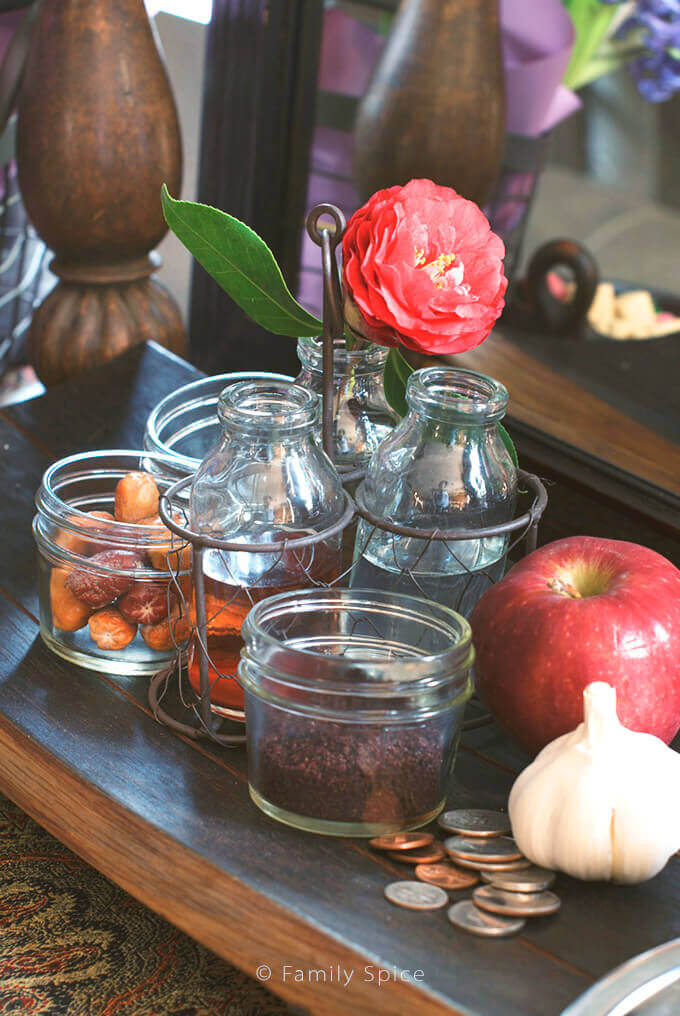
This post contains some affiliate links for your convenience (which means if you make a purchase after clicking a link I will earn a small commission but it won’t cost you a penny more)! Read my full disclosure policy
What is nowruz?
Nowruz is farsi for “new day.” It marks the first day of Farvardin, the first month of the Iranian solar calendar. This first day of the Persian new year also marks the first day of Spring. This holiday began with the Zorastrians over 3000 years ago in Ancient Persia and people of ALL religions celebrate nowruz.
This holiday is not only celebrated in Iran, but also Tajikistan, Azerbaijan, Afghanistan, Kazakhstan, Kyrgyzstan, Albania, Turkmenistan, Uzbekistan, Kurdistan and Georgia. You can learn more about how Persians celebrate nowruz here.
The main course is typically Sabzi Polo Mahi, herb rice with fish. Fish has long symbolized life and good luck and green is the color symbolizing fruitfulness.
Ash-e Reshteh is also served. Persian ash is always a hearty soup. And this ash is cooked with beans, fresh herbs and Persian noodles (reshteh), which is said to symbolically help one succeed in life.
Today I am going share my recipe for Kookoo sabzi. It is like a frittata, but with less eggs and mixed in with fresh herbs and green vegetables. It is believed that eating kookoo sabzi will bring prosperity and happiness in the year to come.
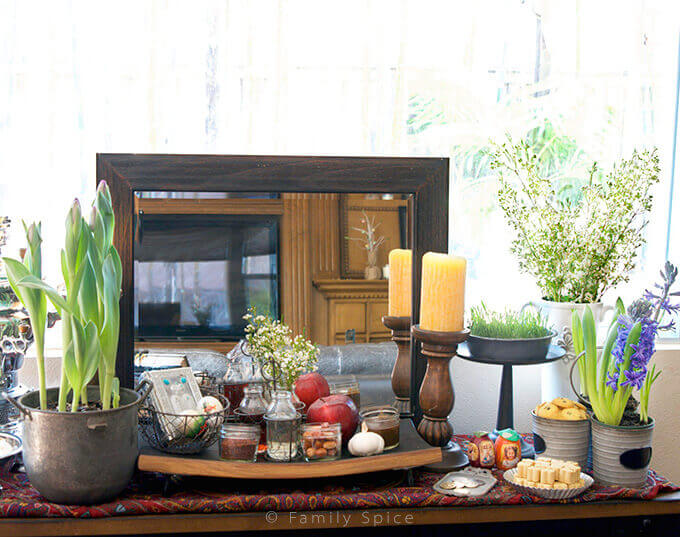
Why this recipe is so awesome
There are many varieties of Persian kookoo. Kookoo (or kuku) is made with eggs. It is not as light and fluffy like a quiche, nor is there any other dairy mixed into it. Kookoo is similar to a frittata, but is made with fewer eggs.
The herbs take center stage in kookoo sabzi, not the eggs. Just enough eggs are used to bind it all together. I add a couple more eggs than many other traditional recipes for kookoo sabzi because of personal preference. Other kookoo recipes feature potatoes (kookoo sibzamini), onions and even string beans.
My version of kuku sabzi is made with only fresh herbs, although you can (and many Persians do) purchase dried herbs. I also like to add fresh spinach to my kookoo sabzi for a nutritional punch, but traditional kookoo sabzi is made with only herbs.
The dish is full of flavor and makes a wonderful dish all year long, and not just spring time. We enjoy kuku for breakfast, light lunch and even a snack. It is quite delicious and I know you will love it, too.
This recipe is baked in the oven, but you can also make kuku sabzi in the instant pot, too.
Ingredients you need
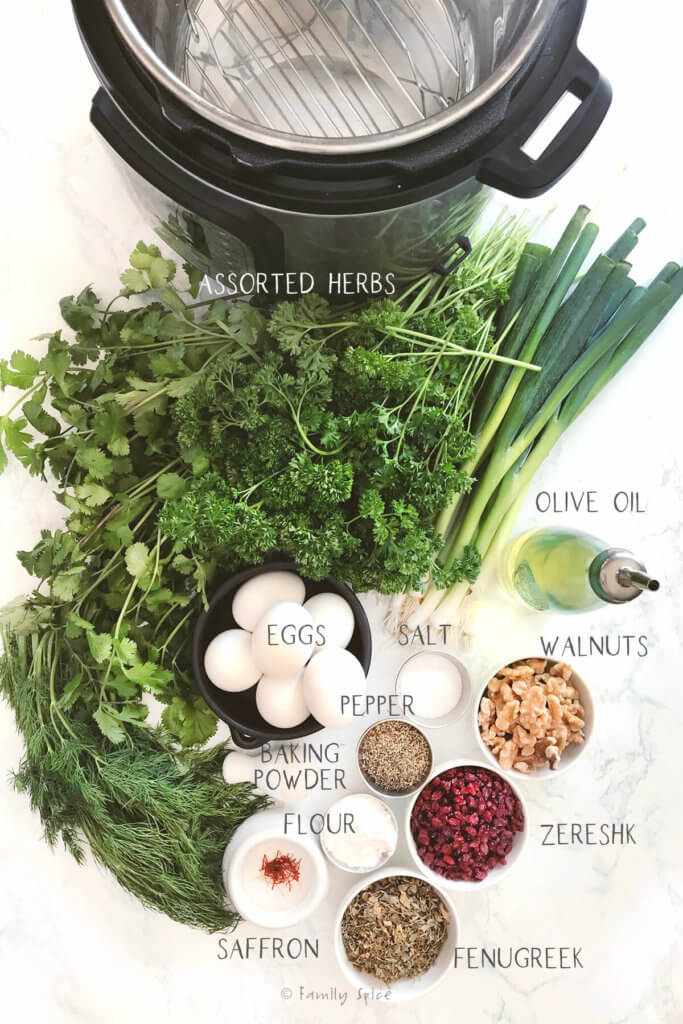
- Saffron: Saffron threads are crushed into a powder using a mortar and pestle. Then hot water is added and the saffron is steeped. The longer it steeps the deeper the color. You want a nice orange-crimson mixture.
- Leek: You can substitute leek with a bundle of green onions.
- Fresh herbs: parsley, cilantro, dill
- Spinach: I have used both fresh and frozen spinach. If using frozen, be sure to thaw it out and squeeze out the excess water.
- Dried fenugreek: I don’t usually find fresh fenugreek so I purchase dried fenugreek.
- Walnuts: These add crunch to the kuku, but you can omit them if you have a nut allergy.
- Dried barberries (zereshk): Barberries are small sour berries. You can substitute them with dried cranberries if you cannot find them in middle eastern stores or order online. You can learn more about zereshk (barberries) here.
- Eggs
- Pantry items: all purpose flour, baking soda, extra virgin olive oil, salt and pepper
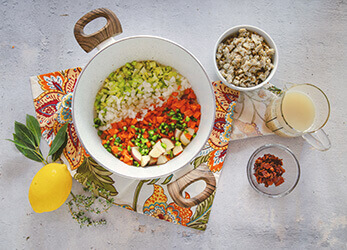
Tools to Use
Step-by-step directions
1. Grind your saffron in a mortar and pestle then steep in hot water.
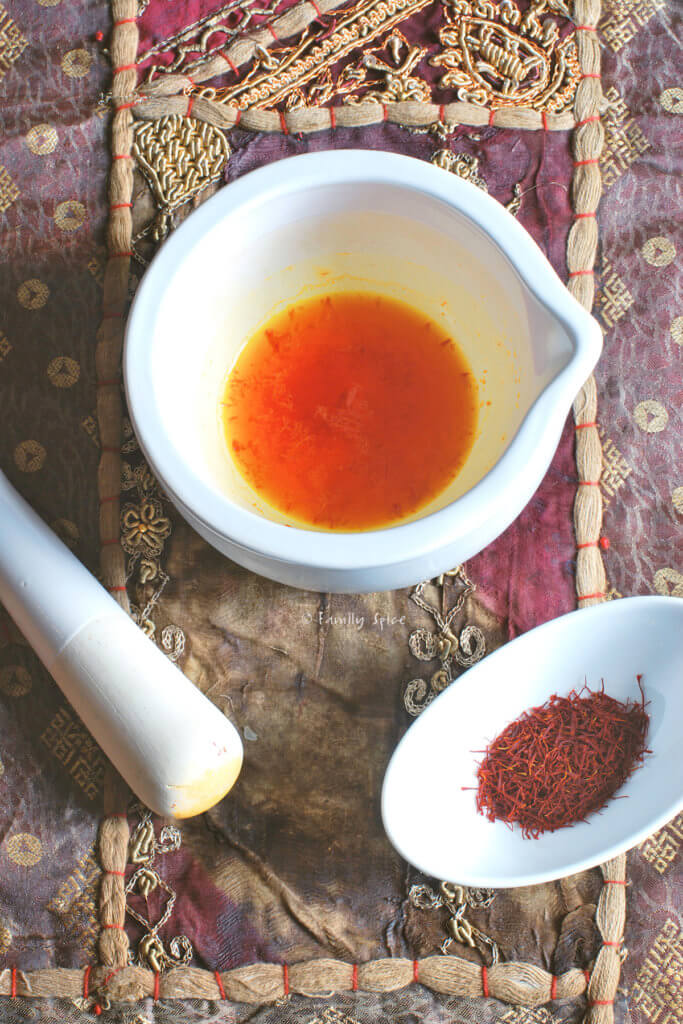
I still have saffron my family has brought for me from Iran, but I still ordered this saffron to try it out. The saffron threads are crimson red, its smells amazing and it produces a bright yellow color to your foods.
2. In a large bowl stir together vegetables and herbs with walnuts, barberries, flour, baking soda, olive oil, salt and pepper.
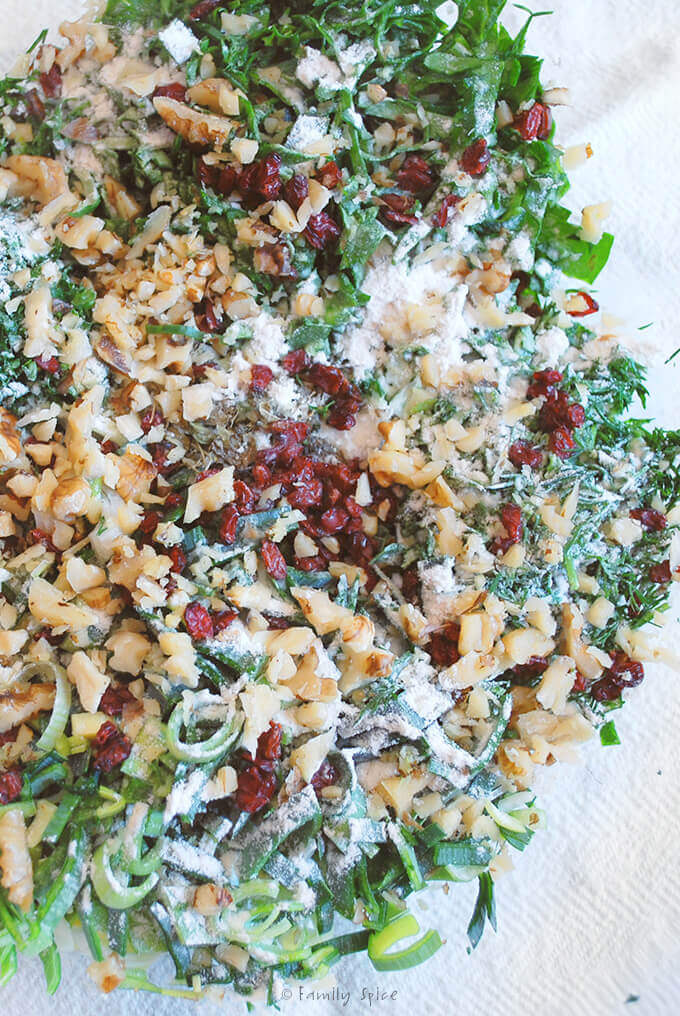
3. In a separate bowl, whisk together eggs with the saffron water. Stir eggs into the vegetable mix.
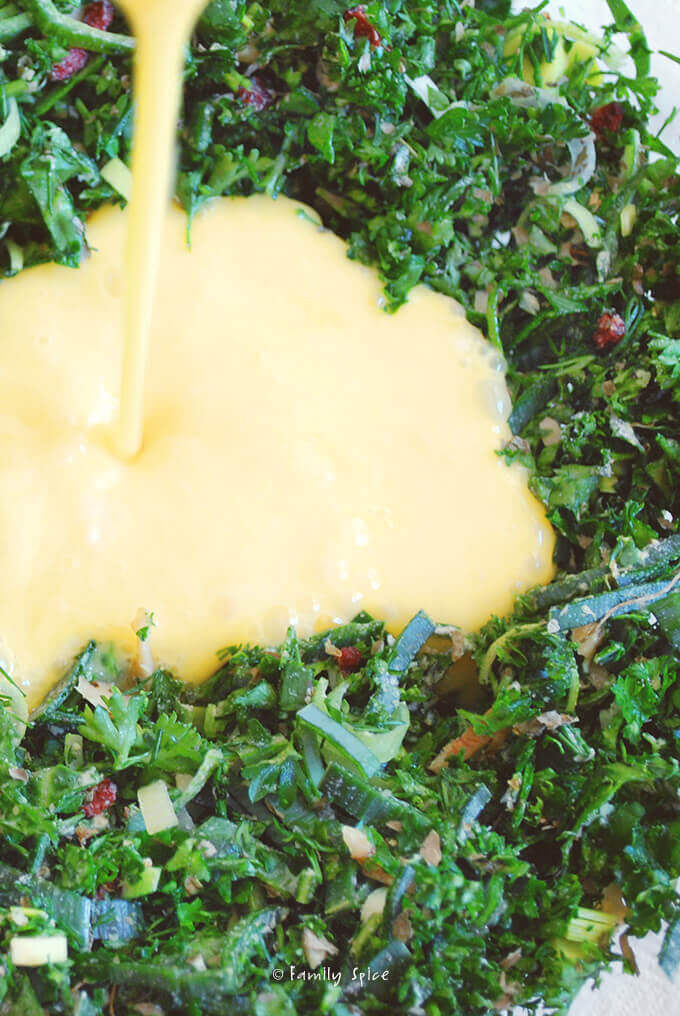
4. Spray 9-inch ceramic pie dish with cooking spray. Pour egg mixture into prepared pie dish. Bake at 350ºF for 40 minutes, or until a toothpick stuck in the center comes out clean. Let it cool for 15 minutes prior to serving. Or cool completely and serve at room temperature.
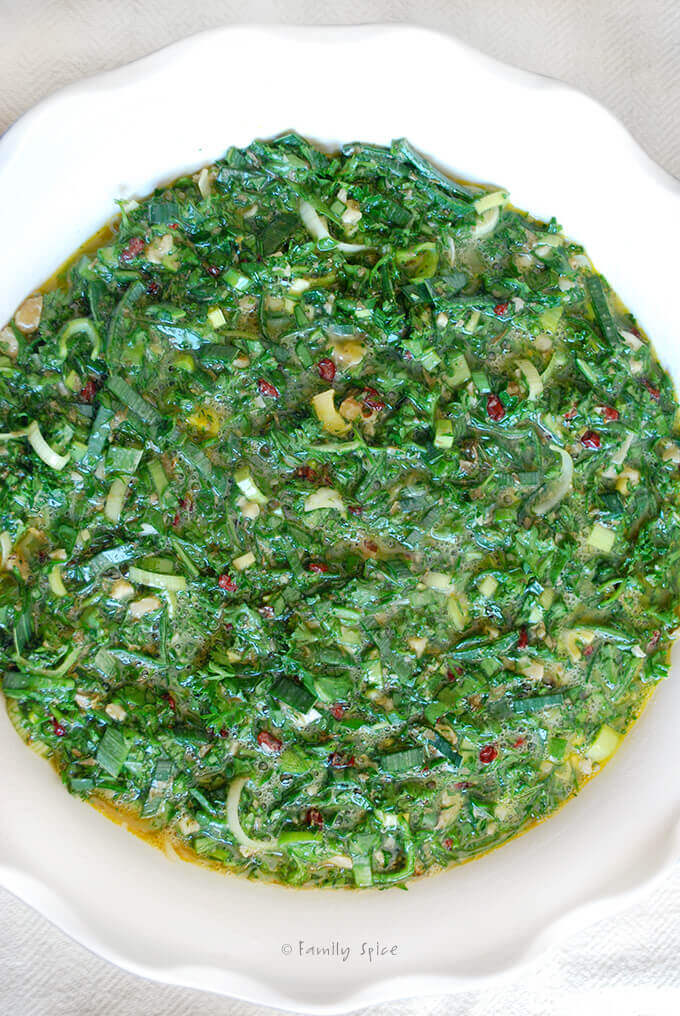
Recipe tips and FAQs
Not only have I mixed spinach in my kuku sabzi, but I have also made it with Swiss chard and kale. Click here for the my kookoo sabzi with Swiss chard recipe.
For Nowruz, we serve kuku sabzi with the main meal. But, you can serve kuku as an appetizer, too. I like to enjoy a slice of kuku sabzi with my morning tea (this is my FAVORITE Persian tea) for breakfast. You can also make a sandwich with it and wrap it in some lavash (flat bread) with a bit of feta cheese and some radishes.
You can also serve kuku sabzi with plain yogurt or even mast o khiar (yogurt with cucumbers). Whether you are enjoying this dish to celebrate spring or just to enjoy the bounty of fresh herbs, there is no wrong way to enjoy kuku sabzi!
Spinach isn’t the only leafy green that I like to use to sneak in some nutrition in my dishes. I also have a this version of kookoo sabzi made with fresh herbs as well as
My grandmother always made her kookoo in a pan on her stove. My mother-in-law still makes her kookoo this way, too. You press the kuku sabzi mixture into a greased pan and cook until the bottom is browned and set. Then, like a quesadilla, you need to transfer the kookoo to a plate in order to flip it over and brown the other side. I’m a no fuss kinda cook and prefer baking my kookoo in a 9-inch pie dish in the oven. Whichever method you choose, you will create a wonderful dish!
Want to learn more about Nowruz and the Persian New Year? I have put together a Nowruz ebook that has all the history, traditions and recipes of Nowruz, in a beautifully photographed ebook. And it’s only $1.99!

Persian Herb Quiche | Kookoo Sabzi (kuku sabzi)
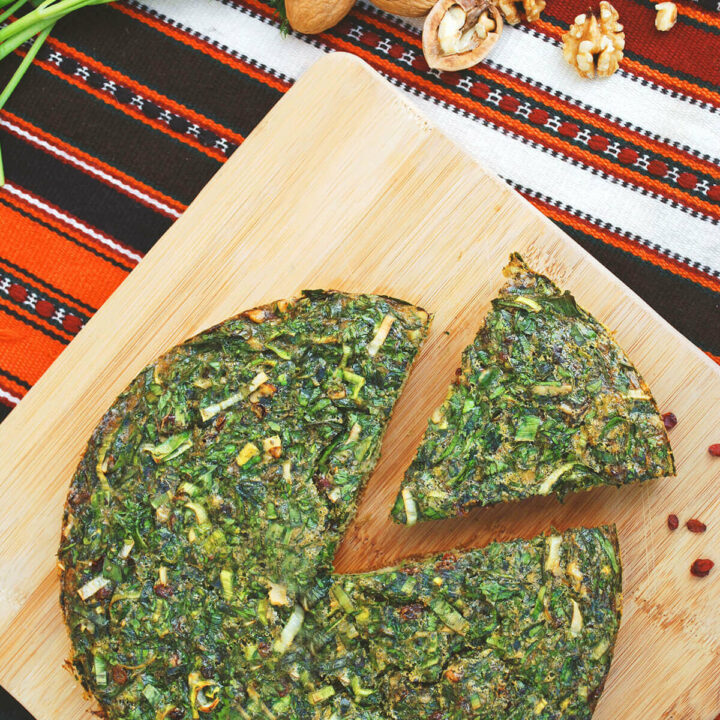
This kookoo sabzi is an aromatic quiche filled with six different herbs and greens. It's a staple dish to celebrate the first day of Spring and the Persian New Year (Nowruz).
Ingredients
- ¼ teaspoon crushed saffron
- 1 TBS hot water
- 1 small leek, rinsed and chopped
- 1 cup chopped parsley, (approximately 1 bunch)
- ¼ cup chopped cilantro
- ¼ cup chopped dill
- ½ cup chopped spinach
- 2 teaspoon dried fenugreek
- ¼ cup chopped walnuts
- 2 TBS dried barberries (zereshk)*
- 1 TBS all purpose flour
- ½ teaspoon baking soda
- 2 TBS extra virgin olive oil
- 1 teaspoon salt
- ¼ teaspoon ground black pepper
- 8 large eggs
Instructions
- Preheat oven to 350ºF and adjust rack to upper-middle position.
- In a small bowl combine saffron and hot water and let steep.
- In a large bowl stir together vegetables and herbs with walnuts, barberries, flour, baking soda, olive oil, salt and pepper.
- In a separate bowl, whisk together eggs with the saffron water.
- Stir eggs into the vegetable mix.
- Spray 9-inch ceramic pie dish with cooking spray.
- Pour egg mixture into prepared pie dish.
- Bake for 40 minutes, or until a toothpick stuck in the center comes out clean.
- Let it cool for 15 minutes prior to serving. Or cool completely and serve at room temperature.
Notes
Serving Suggestions: The key to this dish's flavor is to use only fresh herbs. Spinach is added in our version for more nutritional value.
Cooking Tips: *If you cannot find dried barberries (zereshk) substitute with dried cranberries or currants.
Nutrition Information:
Yield:
10Serving Size:
1 sliceAmount Per Serving: Calories: 115Total Fat: 8.8gSaturated Fat: 1.8gCholesterol: 149mgSodium: 361mgCarbohydrates: 3.8gFiber: 0.9gSugar: 0.8gProtein: 6.5g
PS If you try this recipe, why not leave a star rating in the recipe card right below and/or a review in the comment section further down the page? I always appreciate your feedback.
You can also follow me on Pinterest, Facebook or Instagram. Sign up for my eMail list, too!

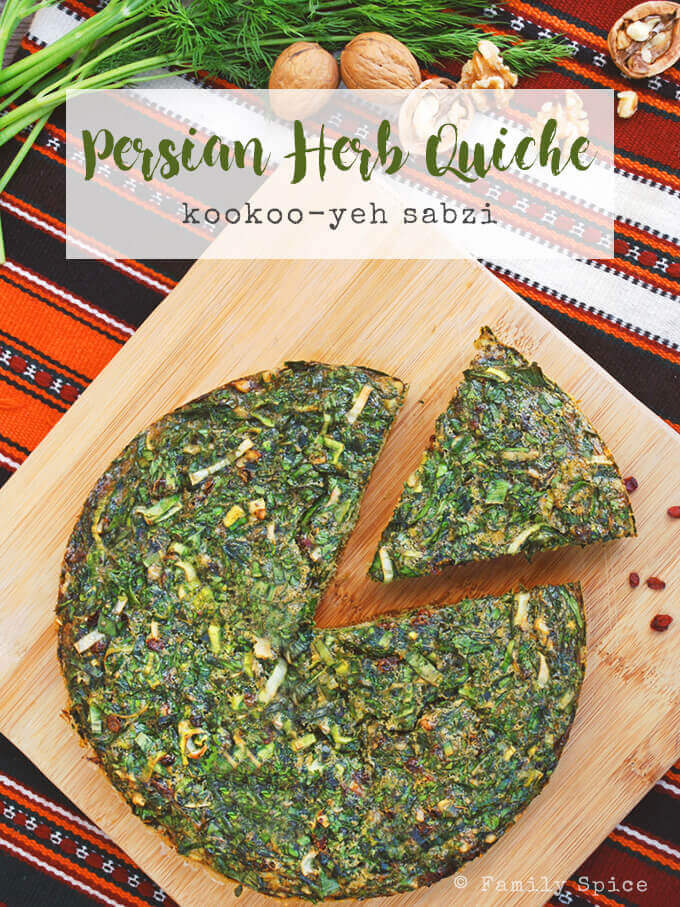
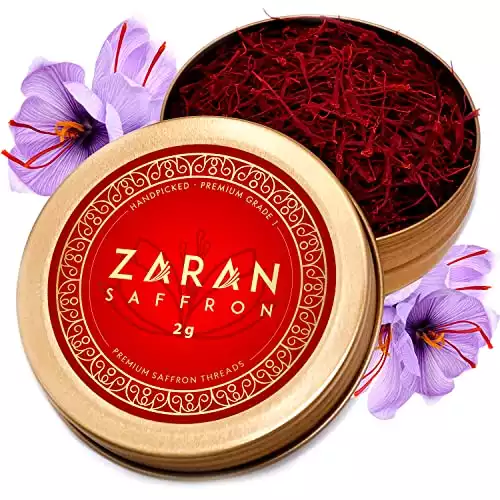
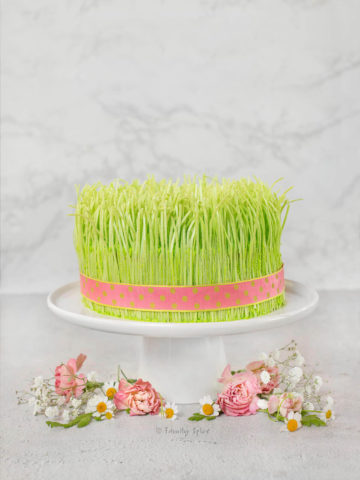
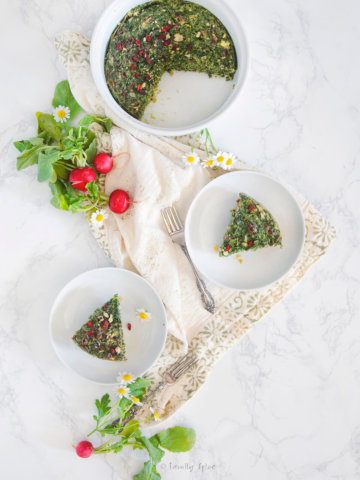
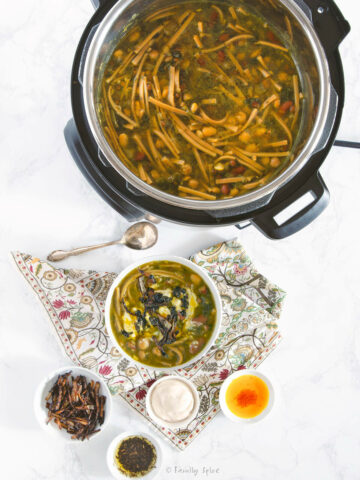
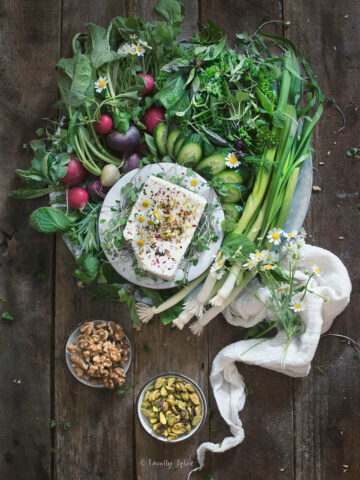
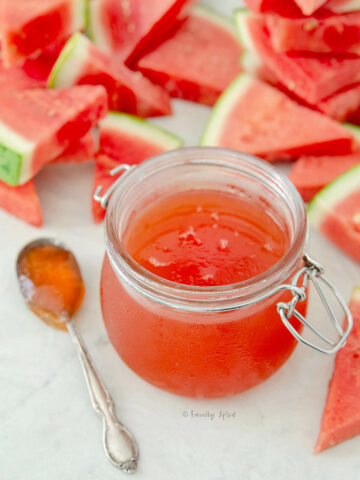
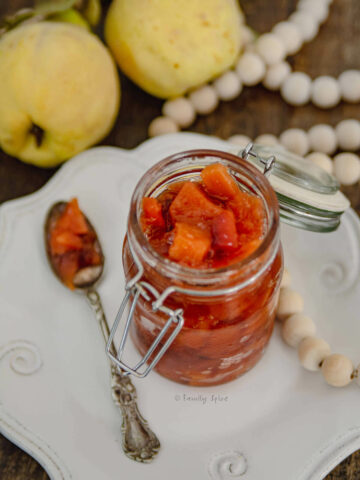
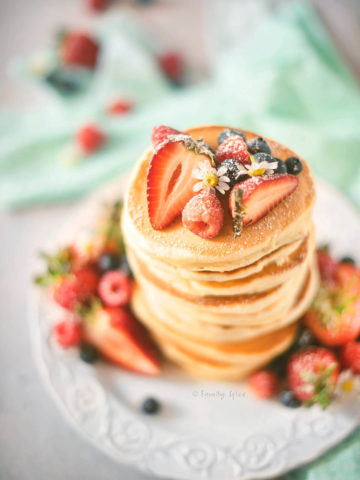
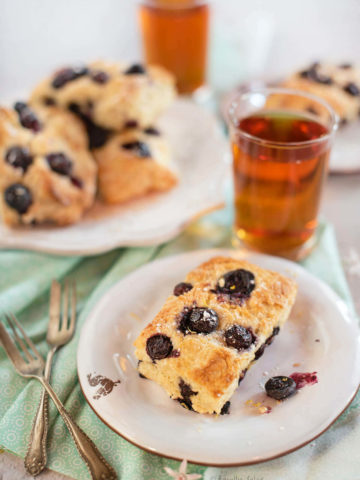
I think I’d bake this, too. Neat dish! And fun read — thanks.
Happy Persian new year Laura! This dish looks so mouthwatering. I love all of the new foods you are introducing me too. Everything Persian I've ever tasted has always been amazing. Thank you for being a part of March's YBR.
This kookoo sabzi looks so good!
Eide shoma mobarak!
"Sabz" is green in farsi. "Sabzi" is for the greens, or herbs, we like to eat raw or to cook. Farsi has a lot of words in Arabic and French, too. I didn't know sabzi is also in Hindi.
Sabzi is a word that Indians use for vegetable side dishes. I am always surprised by how many words Hindi and Persian share.
The Kookoo-yeh Sabzi sounds wonderful. I am definitely going to have to make this one day…
Sabzi is a Farsi word my dear, and its shared between Persian language and Indian because at some point the Persian Empire expanded all the way to China and covered most of India,,, It is not an original Hindu word!!!
Relax. It’s not a competition. No one said it was a Sanskrit word. It’s clearly Persian and anyone from the region knows the history. Get off your high horse.